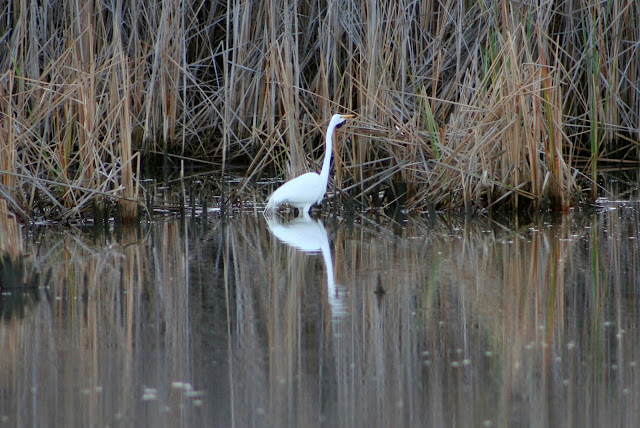Wednesday 2/13/2013
 |
| After about 13 miles north on the other side of the Copano Causeway, we saw a sign that directed us east on Hwy 774 to the Aransas National Wildlife Refuge. |
 |
| The drive seemed like a long drive through the flat lands of Texas farmland. |
 |
| We started to wonder if we had missed our turn, when we finally saw another sign for the refuge. |
 |
| The next turn was on Hwy 2040 East. |
 |
| The total drive seemed like around 30 miles from our park to the refuge. |
 |
| Joe spotted two alligators across a pond sunning on the shore. |
 |
| These guys were at least 6 feet long if not longer. |
 |
| Our next stop was at Bay Overlook which was a 0,1 mile walk to |
 |
| a huge tree and |
 |
| San Antonio Bay. |
 |
| As we walked onto the platform we were meet with an unusual smell. From research I found out that they mark their territory with this musky smell from rubbing their dorsal scent glands on shrubbery. |
 |
| Across Jones Lake Joe spotted another alligator. I could not see it with my bare eyes ( I need new glasses) but with the camera I could see it with the zoom. |
 |
| I then had to enlarge this picture to see it better. |
 |
| Then we saw another Javelina with her 3 babies. |
 |
| Javelinas breed year round, but usually in the spring with the babies being born in the summer. |
 |
| Usually Javelinas have 2-3 babies. This one had 4. |
 |
| This was the larges Live Oak along the trail. After seeing the giant trees in Kings Canyon, we were not impressed. This tree is about 473 years old. |
 |
| Next we drove to the observation tower. |
 |
| It is a bit of a climb to get to the top, |
 |
| over the trees. |
 |
| At the top we could see the boardwalk below that was closed. |
 |
| Looking to the south from the tower. |
 |
| We were told by other people that there were two Whooping Cranes out in the distance. You can see two white spots across the water that are the cranes. |
 |
| I got my zoom lens and then enlarge the picture, but they are still a blurry, |
 |
| On the way out of the refuge we saw 4 deer. |
 |
| When we got back to Fulton, I had Joe drive back to the marsh area on Fulton Beach Road. There we saw a Snowy Egret I believe. |
 |
| A Great Egret |
 |
| I came back to see the Roseate Spoonbill. I got to watch it search for dinner. It swings it's spoonbill from right to left or back and forth as it walks in the water. |
 |
| I think these are Black Skimmers. The lighting was not good, so I am not for sure. |
 |
| I walked down a driveway trying to get a closer look at the Roseate Spoonbill, but it took off, |
 |
| only to return in a few minutes. |
 |
| We headed home again past the Windswept Oaks on Fulton Beach Road. |
 |
| Joe had bought fresh Blue Crabs for dinner before we went to the refuge and had put them on ice while we were gone. |
 |
| He pick up this one to throw into the boiling pot of water. |











No comments:
Post a Comment